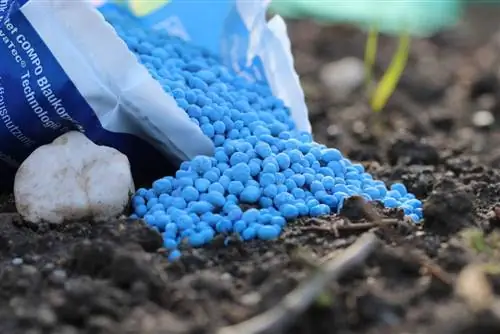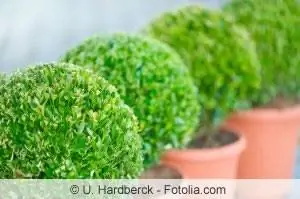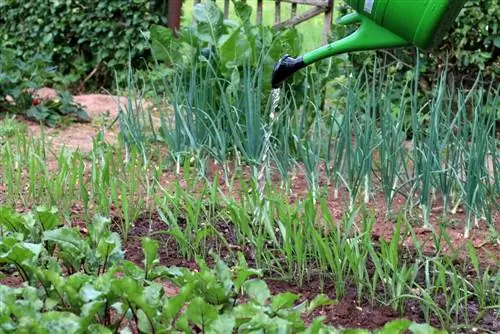- Author admin [email protected].
- Public 2023-12-17 03:39.
- Last modified 2025-01-24 12:45.
Vegetable plants that require a lot of nutrients, such as: B. Potatoes, tomatoes, pumpkins and cucumbers also benefit from this fertilization and are rewarded with productive harvests.
Application of blue grain
This fertilizer is artificially produced and, in addition to nitrogen, contains magnesium, phosphorus, potassium and other trace elements. This combination ensures lush flowering of summer plants and rich yields of vegetables. It is irrelevant whether the granules are dissolved in the irrigation water or applied directly to the ground so that they can melt and penetrate the ground the next time it rains. A wide range of plants can therefore be optimally fertilized. However, it should be remembered that this is a chemical agent. It is not advisable to overdose, because on the one hand this damages the ecological cycle of nature and on the other hand, these chemical substances end up in small quantities in vegetables and in the food.
Correct dosage of blue grain fertilizer
Blue grain is used as fertilizer in many gardens. If the dosage is correct, this is also harmless. Certain commercially available blue grain products make lawns lush, dense and shine a strong green. When fertilizing tomatoes, lawns and other plants, the dosage should be kept as low as possible. Since there are different blue grain products, fertilization depends on the nutrient content of these products and of course on the plant to be fertilized. The manufacturers list the exact dosage on the packaging, which you should stick to. The motto here, however, is: It's better to have a little less than stated than too much! If you spread the grain on the lawn, it should be dry and only watered after the fertilization process has finished. The best time for this process is March and April, i.e. in spring, when the outside temperatures and spring rain ensure optimal distribution. If blue grain is dissolved in the irrigation water, 2 to 3 grains per 5 liters of water are sufficient, but the active ingredients quickly seep into the soil and provide less for the plant.
General Usage Tips
- Fertilizers are intended to ensure lush growth, more productive harvests and strengthening of the plant, but not all soils require the same products. If the soil is naturally rich in nutrients, too much fertilizer can only cause damage.
- Different ornamental and useful plants also require different nutrients. That's why you should pay attention to the instructions on the fertilizer packaging.
- A recommended fertilization with blue grain is especially for lawns, tomatoes, cucumbers and most ornamental shrubs and vegetables.
- As an alternative to blue grain, organic fertilizer can also be used, which can be made in the compost heap using organic kitchen waste.
- Ornamental and useful plants that tend to grow on poor soils sprout up with blue grain and the flowers, fruits and leaves fall by the wayside. The plants become unsightly and the yield decreases or stops altogether.
- Ideally, potted plants can be fertilized with very little blue seed. However, if you overdose, the s alt content increases and the root burns.
- Blue grain fertilization for potted and container plants on balconies or in the house is recommended no more than every 4 weeks, whereby the excess water should be removed from the saucer.
- Flowering plants can be fertilized in the garden every 14 days, although the blue seed dissolved in water should be left overnight so that it dissolves properly.
- For crops such as: B. the tomato, the blue seed can be scattered directly. We recommend 80 to 100 g of beads per square meter.
- Countless different blue grain fertilizers are available commercially and prices vary depending on the size of the packaging and brand. As a rule, 15 kg bags cost 20 to 30 euros and 3 kg packaging costs 5 to 7 euros. The best-known brands include Compo Entec, classic and expert.
- Fertilizing very young plants is not recommended as this harsh fertilizer could attack the still tender roots.
Disadvantages of this type of fertilization
Fertilization with blue grain is very widespread in Germany. However, organic gardeners, parents and animal lovers avoid this because the chemical beads can pose a danger to humans and animals. The topic of fertilizing with blue grain is a very sensitive topic. Basically, a small dosage applies to all plants. It should be borne in mind that parts of the fertilizer end up in the groundwater, including drinking water, and in the case of edible plants, these particles are also eaten. Anyone who grows their own vegetables for organic reasons and then fertilizes them with blue grain is ultimately acting counterproductively.

If blue grain balls are accidentally eaten, it will affect the stomach and intestines. Severe diarrhea, vomiting, stomach cramps, difficulty breathing, irritation of the mucous membranes and even collapse of the circulatory system can be the consequences. For this reason, the blue grain products should definitely be kept away from children. Even if they are already spread out on the ground, caution is required. Children must not be left unattended in the garden until the beads have dissolved and seeped into the ground. In animals, the symptoms of poisoning are similar and a visit to the doctor is necessary for both humans and animals.
Blue grain fertilizers are available commercially for a wide variety of ornamental and crop plants and lawns are also often fertilized with them. The fertilizer ensures lush growth, high-yielding harvests, rich colors and a variety of flowers. Since it is a chemical fertilizer that is not very beneficial to the ecological balance of nature and also contains toxins for the human and animal bodies, precise dosage must be observed. It is better to fertilize a little less than too much and only apply it to soils that are not already nutrient-rich.
What you should know about blue grain fertilizer in brief
Blue grain is a complete fertilizer that can basically be used for all cultivated plants, such as fruit, vegetables, lawns or ornamental plants. Blue grain is available commercially from a wide variety of manufacturers. The difference usually lies in the composition of the ingredients they contain. As a rule, it contains phosphorus, potassium, nitrogen and other trace elements. When buying, you should read the information on the packaging, as different compositions are recommended for different crops!
- Blue grain is a granulate that serves as a storage medium. The beads dissolve slowly and continually release nutrients.
- However, these nutrients are only relevant for the plants. Microorganisms in the soil cannot process the fertilizer.
What should you pay attention to when spreading blue grain?
When fertilizing lawns, they should be dry and then watered sufficiently.
If you want to fertilize plants, you should sprinkle blue grain sparingly on the respective cultivated area.
If you want to sow plant seeds or plant fresh plants, you should apply the fertilizer three weeks earlier so that the soil can absorb the nutrients.
When fertilizing houseplants, make sure that the irrigation water does not get into the hands of children and that pets do not drink from the saucers of fertilized plants.
In general, when it comes to children and animals in the house and garden, you should consider whether you should use a natural fertilizer instead of blue grain.
How is it worth using blue grain?
In addition to lawns, blue grain fertilization is also recommended for chloride-sensitive plants, such as strawberries.
Blue grain can also be used as top fertilizer. This means that the fertilizer is applied in several doses as the plants grow. This is particularly recommended for fruits and vegetables, such as cucumbers or tomatoes. In this way, the nutrient requirements of the plants are continuously met.






